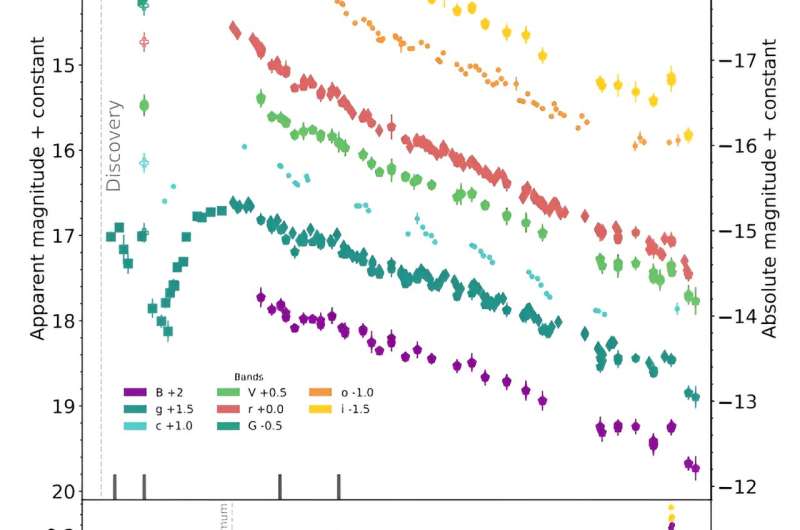October 2, 2023 report
This article has been reviewed according to Science X's editorial process and policies. Editors have highlighted the following attributes while ensuring the content's credibility:
fact-checked
preprint
trusted source
proofread
Observations explore the properties of Type Ic supernova SN 2022jli

An international team of astronomers has performed multi-wavelength photometric and spectroscopic observations of a recently discovered Type Ic supernova known as SN 2022jli. Results of the observational campaign, published September 22 on the pre-print server arXiv, indicate that the supernova has unusual properties.
In general, supernovae (SNe) are powerful and luminous stellar explosions. They offer essential clues into the evolution of stars and galaxies and are divided by astronomers into two groups based on their atomic spectra: Type I and Type II. Type I SNe lack hydrogen in their spectra, while those of Type II showcase spectral lines of hydrogen.
Type Ic supernovae (SNe Ic) are a sub-class of core-collapse SNe that exhibit no helium or hydrogen lines in their spectra. They represent the explosions of the most stripped massive stars, but their progenitors and explosion mechanisms remain unclear.
SN 2022jli was first identified in May 2022 by the Kleinkaroo Observatory, as a transient in the galaxy NGC 157. Further observations of this transient have found that it is an SN Ic at a distance of some 75 million light years.
A group of astronomers led by Thomas Moore of the Queen's University Belfast, UK, has conducted an extensive follow-up observing campaign of SN 2022jli using various ground-based telescopes and space observatories. The observations cover the period from about 50 days before to 200 days after the supernova's maximum light.
"We have presented detailed, multi-wavelength, high cadence observations of the unprecedented Type Ic SN 2022jli," the researchers wrote.
The observations found that SN 2022jli showcases an unusually long-lived, luminous early excess followed by a long rise time, and slow spectroscopic evolution. The duration of the initial excess (at least 25 days) is unprecedented for a Type Ic SN and its bolometric light curve peaks at least 59 days after explosion.
The astronomers underlined that the long rise time of SN 2022jli could be due to a large ejecta mass. They estimate that the ejecta mass of this supernova is about 12 solar masses, adding that further nebular phase spectroscopy may provide an independent estimate of its core mass.
The researchers also detected a periodic behavior in the optical light curve of SN 2022jli. They measured a period of approximately 12.5 days and amplitude of about 1 percent of the supernova maximum light, repeating over a time window of at least 200 days.
"This is the first time that repeated periodic oscillations, over many cycles, have been detected in a supernova light curve," the scientist's noted.
According to the authors of the paper, such periodicity could be attributed to discrete episodes of shock heating from interaction with a structured circumstellar medium produced through modulated mass-loss of the progenitor star in a binary system. Another scenario taken into account by the team is a companion-compact object interaction. Further multi-wavelength monitoring of SN 2022jli is required to find out which of these hypotheses is true.
More information: Moore T. et al, SN 2022jli: a type Ic supernova with periodic modulation of its light curve and an unusually long rise, arXiv (2023). DOI: 10.48550/arxiv.2309.12750
Journal information: arXiv
© 2023 Science X Network





















